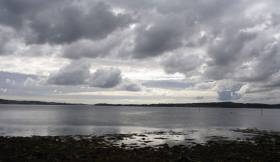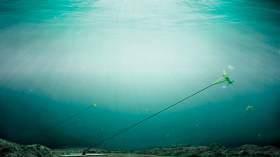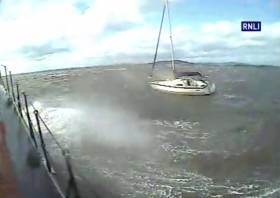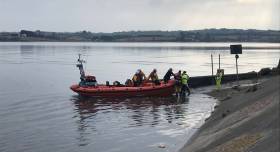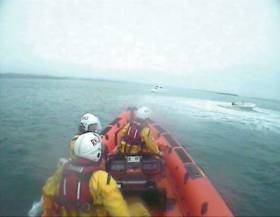Displaying items by tag: Strangford Lough
Mystery Hum Baffles Strangford Lough Residents
Residents around Strangford Lough were baffled at the weekend of a mysterious ‘humming’ sound heard around its waters, as the Belfast Telegraph reports.
The droning noise can be faintly detected in a video posted by Ian McConnell on Twitter, who said the sound lasted for “hours” into the small hours of Saturday 9 November.
Another Twitter user conducted a spectrum analysis of the sound, revealing its peak frequencies.
Anyone else hear this weird #hum over Strangford Lough area last night? What is it??? It went on for hours. pic.twitter.com/2Lxu1rLcxz
— Tallow Ketch (@TallowKetch) November 9, 2019
A quick analysis with my spectrum analyser app gives me these peak frequencies. pic.twitter.com/R7tb7Y3Cd0
— Mark Stronge (@markoftec) November 10, 2019
But speculation as to the origins of the noise remains rife, with suggestions ranging from the newly introduced 5G mobile network to a car horn and even ‘the sound of Brexit’.
The Belfast Telegraph has more on the story HERE.
NI Coastguard Teams Rescue Pup Cut Off By Tide In Strangford Lough
Coastguard teams from Bangor and Portaferry were tasked to Strangford Lough on Saturday afternoon (17 August) to rescue a young dog stranded by the tide at Island Hill.
The pup’s worried owner “was in the mindset of attempting a rescue himself” but let the coastguard rescuers — one of whom is a dog handler with K9 Search and Rescue NI — handle the situation, according to Belfast Coastguard.
With a little patience to win over the frightened animal’s trust, the dog was soon in the arms of coastguard volunteers and reunited with its owner on dry land.
Belfast Coastguard reminded all pet owners: “Please don’t enter the water after your dog. Dial 999 and ask for the coastguard.”
A volunteer crew from Portaferry RNLI launched to a 999 call in the early hours of Sunday morning (14 April) reporting that a yacht with three people on board had hit rocks at Rainey Island near Ballydoran in Strangford Lough.
The lifeboat launched at 1.50am in cloudy weather conditions with good visibility and Force 4 south-easterly winds. The Portaferry crew arrived on scene 35 minute later with good visibility and a moderate sea state.
When the volunteer crew arrived on scene, they found that the yacht had made itself off the rocks and proceeded into Strangford Lough Yacht Club.
Portaferry RNLI closely followed the boat to the pontoon, went alongside yacht and checked that all onboard were safe and well before returning to station at 3.35am.
Northern Ireland Aims To Make The Most Of Its Tidal Energy Resources
#SeaPower - Northern Ireland is well placed to capitalise on the growing trend towards renewable energy thanks to its unique tidal resources, according to a leading researcher in the field.
Dr Carwyn Frost of Queen’s University Belfast tells Emily McDaid of local tech incubator Catalyst Inc that the Narrows between Strangford Lough and the Irish Sea have the perfect conditions to harness the power of the sea’s tides — in shallow waters away from ocean swell, and more accessible than similar sites in the far north of Scotland.
The area was previously home to the world’s first tidal power station in the form of the SeaGen turbine, and has since been a test site for new projects such as the PowerKite developing the next generation of tidal energy devices.
Silicon Republic has much more on the story HERE.
Three Yachts Rescued In Strangford Lough During Storm Ali
#Rescue - Newcastle RNLI was involved in the rescue of three yachts in Strangford Lough during Storm Ali on Wednesday (19 September).
The lifeboat volunteers were first alerted at 11.40am to go the aid of a stricken yacht at Newtownards Sailing Club in Co Down.
As the all-weather lifeboat launched, under coxswain William Chambers, it quickly became apparent the challenging weather conditions the crew would face on their passage to Newtownards.
The main water tight doors were closed and all crew seated as they faced eight-metre waves hitting from the side.
A Force 8 gale was blowing as the crew approached Strangford Lough. It was some 90 minutes later before the seas started to settle as the lifeboat was sheltered by the shore.
On arrival at Newtownards at 2.15pm, the coastguard was concerned that there may be a person onboard the weather-beaten yacht, Newcastle RNLI confirmed that nobody had been on the boat and she was safely on the mooring.
The lifeboat was then requested to go the aid of another yacht drifting across the lough from White Rock and Kircubbin, but unfortunately by the time the volunteers reached the vessel there was nothing they could do as it was on the rocks on an ebbing tide.
On return to station, approaching Portaferry, the crew were alerted to a third yacht in difficulty. The crew established a tow line and managed to free the vessel and towed it to the safety off a mooring in Strangford.
Leaving the sheltered waters of Strangford Lough, the lifeboat and its crew once again faced mountainous seas and the coxswain decided to stop in Ardglass Marina for an hour to let the wind decrease and the wave size drop.
Leaving Ardglass around 6pm, the crew faced large but bearable seas, making it back to Newcastle an hour later.
“This was a challenging day for our volunteers given that we launched into rough seas when Storm Ali was at its worst,” said Chambers of the seven-hour shout.
“It was also uncertain at that point if there was a life at risk onboard the yacht. Thankfully there wasn’t in this case.
“It was a long and challenging day but our volunteers are highly skilled and trained for these situations and were delighted to be able to help.”
Two Callouts In 24 Hours Keep Portaferry Lifeboat Volunteers Busy
#RNLI - Yesterday evening (Saturday 15 September) at 4.45pm, a volunteer RNLI crew from Portaferry launched to the aid of two men in trouble in the water just off Ballyhenry Island.
The two men had been using a personal watercraft when one of them had fallen from the vessel and was struggling to get back to it.
The second man, realising that the first was in difficulty, started to swim from the shore to try and help at the small island, around 1.5 miles north of Portaferry on the eastern shore of Strangford Lough in Co Down.
At the time, the weather was cloudy with good visibility, a southerly wind and calm seas.
Portaferry RNLI launched at 4.50pm and 10 minutes later were on scene, where the lifeboat crew took both men on board before returning them to Cooke Street Quay in Portaferry and into the care of the Portaferry Coastguard team.
The second launch was this morning (Sunday 16 September) in response to a Mayday call regarding an angler who had fallen from rocks into the sea just off Ardglass Golf Course.
Pagers sounded at 8.36am and the crew were on the water six minutes later, arriving on scene at 9.10am.
Weather conditions at the time were overcast with good visibility, a south-westerly Force 3 wind and moderate seas.
The male casualty had in the meantime been picked up by a local boat and returned to shore at Ardglass Marina. The lifeboat continued to the marina where they administered casualty care before leaving him in the care of the local coastguard team at 9.40am.
Commenting on the weekend’s events, Portaferry RNLI lifeboat operations manager Simon Rogers said: “We can go for weeks without any callouts, but during those quiet periods our volunteer boat and shore crew members train hard every week, preparing for situations such as this.
“It is thanks to their dedication and hard work that we are able to respond so quickly an as often as required to help those in trouble at sea.”
#RNLI - Yesterday afternoon (Tuesday 6 March), a volunteer crew from Portaferry RNLI was tasked to go the aid of a woman stranded on one of Strangford Lough’s many islands.
The woman had been walking her dog on Rough Island, a small island which lies just off Island Hill between Newtownards and Comber in Co Down.
The island is accessible on foot at low tide via a concrete causeway connecting the mainland to the small island. However, the woman had been cut off when the causeway became submerged by the incoming tide.
Weather conditions at the time were partly cloudy with good visibility, and the volunteer RNLI crew were quickly on scene.
The woman and her dog were then taken on board the lifeboat and transported the short distance to shore and into the safe hands of the waiting Bangor Coast Guard team.
#RNLI - A volunteer crew from Portaferry RNLI were preparing for a training exercise yesterday morning (Saturday 14 October) when they received a call to go to the aid of a man who had been thrown from a small motor boat which was subsequently spinning out of control in Strangford Lough.
The call was received at 10.53am and the volunteer lifeboat crew were on the water and on their way to the casualty by within two minutes, heading for a location roughly half a mile from Don O’Neill Island.
Weather conditions were cloudy with fair visibility, a Force 3 southerly wind and calm sea conditions.
On arrival at 11am, the volunteer crew learnt that the man had been thrown clear of the small dory when the craft had developed steering problems and started spinning in circles.
He was then lifted on board another boat which had been at the scene at the time, and taken ashore by them.
With the help of other boats attending a regatta in the area at the time, the Portaferry RNLI crew eventually brought the spinning craft under control, after which they attached tow lines to the vessel and towed it back into Portaferry Marina.
#RNLI - Portaferry RNLI was called out yesterday afternoon (Wednesday 28 June) to rescue a group of four people who had become stranded on an island at the north end of Strangford Lough.
The two women and two children had become stranded on Rough Island, a small island which lies just off Island Hill in Strangford Lough between Newtownards and Comber in Co Down.
The island is accessible on foot at low tide via a concrete causeway connecting the mainland to the small island. However, the group had been cut off when the causeway submerged with the incoming tide.
The coastguard request to launch was received by Portaferry RNLI at 4.34pm and the volunteer lifeboat crew were on the water six minutes later, arriving on scene at 5.06pm.
Weather conditions at the time were partly cloudy with good visibility and calm seas.
The women and children were taken on board the lifeboat and transported the short distance to safety on shore. Once satisfied they were out of danger, the lifeboat crew returned to station ready for service.
#RNLI - The volunteer lifeboat crew at Portaferry RNLI responded for the second time in 48 hours to a launch request yesterday evening (Thursday 4 May) to go to the aid of five men on board a 7m yacht experiencing difficulty on Strangford Lough.
The Atlantic 85 inshore lifeboat launched at 8.45pm for the reported location of the casualty, which was just north of Don O’Neill Island in Strangford Lough.
The lifeboat crew arrived on scene at 8.52pm in clear weather and good visibility, but with a Force 6 north-easterly was creating choppy sea conditions with a moderate two-metre swell.
The five men on the sailing boat had experienced some heavy going and though they were in no longer in any immediate danger, the lifeboat crew made the decision to escort them into the safe waters of Ringhaddy Sound.
Less than 48 hours previously, the Portaferry lifeboat crew launched to the aid of five men and two women stranded on two adjacent islands in Strangford Lough.
The group had been on a 6m cabin cruiser that started to experience electrical problems before they decided to beach the craft on Salt Island, after three of the party were put ashore on neighbouring Green Island.
The Portaferry Lifeboat crew arrived on scene at 11.22am, nine minutes after launch, and took on board the five people on Salt Island, taking them to Killyleagh before returning to Green Island for the remaining individuals.
At the time of the launch, the weather was sunny with very good visibility, a Force 3 easterly wind and calm sea conditions.
Commenting on the rescue, Portaferry RNLI lifeboat operations manager Brian Bailie said: “Once again all the hard work and hours invested in training has paid off with a happy ending to today’s rescue.
“With the start of the good weather and more and more craft taking to the water, it is increasingly important that everyone respects the water and makes all the necessary checks before going on the water.”


























